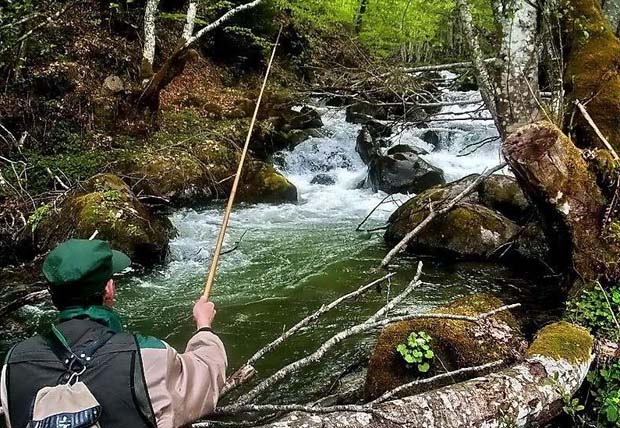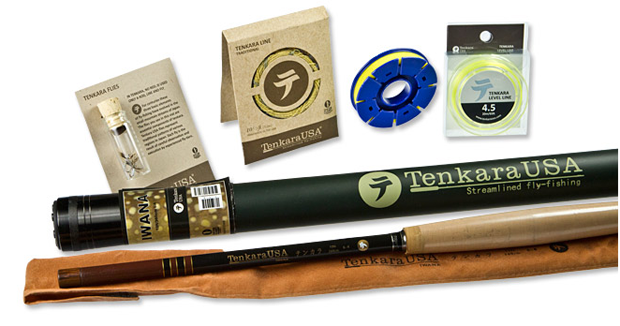Centuries-old tenkara is becoming a hit on streams in the American West
[dropcap]I[/dropcap]t is snowing in the Sierras, and my 7-year-old niece, Mayli, scrambles up one of the icy boulders that hangs over this eastern California creek. We’re here to fish for trout, but it’s December, and the forecast – for both weather and fish – is grim. The rivers have been skinny for weeks, and snow blankets the mountains, sending the rainbows, browns and cutthroats into hiding.

The art of Tenkara. A thousand year old art of fly fishing gets a new life in western U. S. states. It’s easy to learn how to, and it’s inexpensive. It’s a great way to fish for crappie and bass.
Our companion, Daniel Galhardo, bounds up a steep granite outcrop, eager to teach us an ancient way to fish. Galhardo has been fishing throughout the three decades of his life, starting with rods he made from branches in Brazil, where he was born. He’s slim and graceful, with neatly cropped hair and beard, dressed as if for an alpine ascent in a down jacket and thick-soled boots. But tucked into his waistband is a fishing net he made from a branch of Jeffrey pine, and in his hand he carries a 12-foot-long rod of his own design, based on models he saw in Japan, where he learned about a fly-fishing tradition called Tenkara.
Tenkara, which roughly means “from heaven,” is a modern name for a centuries-old Japanese fishing technique. It had almost died out by the 1980s, when a professor of sports science named Hisao Ishigaki started researching its history and demonstrated it on Japanese TV. Records are scarce, but it’s known that tenkara was practiced by highland peasants who fished mountain streams for char and trout to sell at market. The thick brush and deep gullies left little room for long lines or sweeping back-casts, so the peasants devised clever ways to swing, roll and slingshot flies to reach tucked-away fish. Sawa no bori, waterfall-climbing skills, often came in handy.
A tenkara rig could not be simpler – just a pole, a line and a fly. No reel. The rod is longer and thinner than its Western cousins, and it tapers dramatically to a strong but flexible tip and a fixed length of line, usually between 10 to 25 feet, depending on the angler’s skill and choice of locale. Together, a pole and line provide 24 to 41 feet of reach, just enough for the tight corners of a mountain stream, where perfect placement is the challenge. Because the rod is built from telescoping segments of graphite or bamboo, it collapses down to a baton that can fit into a back pocket. The rod, with a spool of line, weighs just ounces. Flies, called kebari, are tied with a reverse hackle, a feather that flares like a tutu towards the hook’s eye to help them ride currents. Tenkara anglers, always economical, use just a handful of patterns rather than lugging an arsenal of flies.
Galhardo found his first tenkara rod in a tackle shop in Japan in 2008 while studying fly-fishing traditions around the world. “It was exactly what I’d been looking for,” he says. “As I’d advanced with fishing, it became all about second-guessing which fly to use, which reel, which rod.” When he was a kid, he explains, “fishing had been simple, joyful, relaxing. Tenkara brought that all back to me.”
Galhardo was so inspired that within a year he quit his banking job to found Tenkara USA, introducing the method outside of Japan for the first time. He started the company in San Francisco, then moved it to Boulder, Colo. Other burnt-out anglers and gear minimalists quickly discovered what Galhardo had; today, Galhardo travels around the country and abroad for clinics and trade shows, including the annual Tenkara USA Summit. Fly-fishing guides in practically every state with fishable rivers have embraced the method, and the fly-fishing giant Orvis now sells Galhardo’s rods ($215 for a complete outfit).
Tenkara has also caught the attention of Yvon Chouinard, the well-known environmentalist and founder of the Patagonia outdoor gear and clothing company, whose book on the subject, Simple Fly Fishing: Techniques for Tenkara and Rod & Reel, comes out this month. Chouinard received a tenkara rod as a gift from a Japanese friend in the 1990s, but he didn’t know what it was, so he let it languish in a closet. Some 15 years later, an Italian octogenarian who still hammers his own hooks and twists horsehair into line taught Chouinard a technique from Italy’s Sesia River Valley that’s remarkably similar to tenkara. After Chouinard got home, he dusted off his tenkara rod. It’s never been stowed away again. He told me that he catches four times as many fish in an afternoon than he ever did with a rod and reel.







